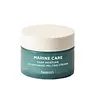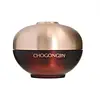What's inside
What's inside
 Key Ingredients
Key Ingredients

 Benefits
Benefits

 Concerns
Concerns

 Ingredients Side-by-side
Ingredients Side-by-side

Water
Skin ConditioningParaffinum Liquidum
EmollientPetrolatum
EmollientMicrocrystalline Wax
Emulsion StabilisingGlycerin
HumectantPhytosteryl/Isostearyl/Cetyl/Stearyl/Behenyl Dimer Dilinoleate
Skin ConditioningButylene Glycol Dicaprylate/Dicaprate
EmollientZinc Stearate
Cosmetic ColorantNiacinamide
SmoothingBeeswax
Emulsion StabilisingCetyl PEG/PPG-10/1 Dimethicone
EmulsifyingSodium Chloride
MaskingUndaria Pinnatifida Extract
Skin ConditioningEcklonia Cava Extract
Skin ConditioningSorbitan Olivate
EmulsifyingOzokerite
Emulsion StabilisingLaminaria Japonica Extract
Skin ProtectingHizikia Fusiforme Extract
Skin ConditioningPanthenol
Skin ConditioningHydrolyzed Collagen
EmollientLeontopodium Alpinum Callus Culture Extract
AntioxidantUlva Lactuca Extract
Skin ConditioningSolidago Virgaurea Extract
Skin ConditioningPorphyra Yezoensis Extract
Skin ConditioningLaminaria Digitata Extract
Skin ProtectingLaminaria Cloustoni Extract
Skin ProtectingEnteromorpha Compressa Extract
Skin ProtectingCodium Tomentosum Extract
Skin ProtectingCodium Fragile Extract
Skin ConditioningAgarum Cribrosum Extract
Skin ConditioningEthylhexylglycerin
Skin ConditioningSodium Hyaluronate
HumectantCopper Tripeptide-1
Skin ConditioningAcetyl Hexapeptide-8
HumectantAdenosine
Skin ConditioningButylene Glycol
Humectant1,2-Hexanediol
Skin ConditioningHexyl Laurate
EmollientPolyglyceryl-4 Isostearate
EmulsifyingHydroxyacetophenone
AntioxidantHydrogenated Lecithin
EmulsifyingParfum
MaskingLinalool
PerfumingButylphenyl Methylpropional
PerfumingDisodium EDTA
Water, Paraffinum Liquidum, Petrolatum, Microcrystalline Wax, Glycerin, Phytosteryl/Isostearyl/Cetyl/Stearyl/Behenyl Dimer Dilinoleate, Butylene Glycol Dicaprylate/Dicaprate, Zinc Stearate, Niacinamide, Beeswax, Cetyl PEG/PPG-10/1 Dimethicone, Sodium Chloride, Undaria Pinnatifida Extract, Ecklonia Cava Extract, Sorbitan Olivate, Ozokerite, Laminaria Japonica Extract, Hizikia Fusiforme Extract, Panthenol, Hydrolyzed Collagen, Leontopodium Alpinum Callus Culture Extract, Ulva Lactuca Extract, Solidago Virgaurea Extract, Porphyra Yezoensis Extract, Laminaria Digitata Extract, Laminaria Cloustoni Extract, Enteromorpha Compressa Extract, Codium Tomentosum Extract, Codium Fragile Extract, Agarum Cribrosum Extract, Ethylhexylglycerin, Sodium Hyaluronate, Copper Tripeptide-1, Acetyl Hexapeptide-8, Adenosine, Butylene Glycol, 1,2-Hexanediol, Hexyl Laurate, Polyglyceryl-4 Isostearate, Hydroxyacetophenone, Hydrogenated Lecithin, Parfum, Linalool, Butylphenyl Methylpropional, Disodium EDTA
Phellinus Linteus Extract
Skin ConditioningDipropylene Glycol
HumectantDimethicone
EmollientCyclopentasiloxane
EmollientButylene Glycol
HumectantWater
Skin ConditioningGlycerin
HumectantCetearyl Alcohol
EmollientPCA Dimethicone
Skin ConditioningPentylene Glycol
Skin ConditioningGlycereth-26
HumectantNiacinamide
SmoothingPetrolatum
EmollientTrisiloxane
Skin ConditioningGlyceryl Stearate Se
EmulsifyingChlorella Vulgaris Extract
Skin ConditioningTheobroma Cacao Seed Extract
AntioxidantMacadamia Integrifolia Seed Oil
Skin ConditioningVincetoxicum Atratum Extract
Skin ConditioningAlthaea Rosea Flower Extract
Skin ConditioningAngelica Gigas Extract
Skin ConditioningCornus Officinalis Fruit Extract
Skin ConditioningThymus Vulgaris Extract
PerfumingVelvet Extract
HumectantHydrolyzed Hyaluronic Acid
HumectantHelianthus Annuus Seed Oil
EmollientCandida Bombicola/Glucose/Methyl Rapeseedate Ferment
AntimicrobialPanax Ginseng Root Extract
EmollientEclipta Prostrata Extract
Skin ConditioningMelia Azadirachta Leaf Extract
Skin ConditioningMelia Azadirachta Flower Extract
Skin ConditioningOcimum Sanctum Leaf Extract
Skin ConditioningCurcuma Longa Root Extract
MaskingCorallina Officinalis Extract
Skin ConditioningMacadamia Ternifolia Seed Oil
EmollientMoringa Oleifera Seed Oil
EmollientGlyceryl Stearate
EmollientPEG-100 Stearate
Ammonium Acryloyldimethyltaurate/Vp Copolymer
PEG-150 Distearate
EmulsifyingCaprylyl Glycol
EmollientGlucose
HumectantFructooligosaccharides
HumectantFructose
HumectantDextrin
AbsorbentDipotassium Glycyrrhizate
HumectantAdenosine
Skin Conditioning1,2-Hexanediol
Skin ConditioningSodium Phytate
Ceramide NP
Skin ConditioningPhytosphingosine
Skin ConditioningEthylhexylglycerin
Skin Conditioning3-O-Ethyl Ascorbic Acid
Skin ConditioningPolyglyceryl-10 Pentastearate
Skin ConditioningMethylpropanediol
SolventSodium Stearoyl Glutamate
CleansingHydrolyzed Elastin
EmollientAcetyl Hexapeptide-8
HumectantXanthan Gum
EmulsifyingBHT
AntioxidantPhenoxyethanol
PreservativeParfum
MaskingBenzyl Salicylate
PerfumingAlpha-Isomethyl Ionone
PerfumingCitronellol
PerfumingGeraniol
PerfumingLinalool
PerfumingLimonene
PerfumingHydroxycitronellal
PerfumingHexyl Cinnamal
PerfumingCI 77480
Cosmetic ColorantPhellinus Linteus Extract, Dipropylene Glycol, Dimethicone, Cyclopentasiloxane, Butylene Glycol, Water, Glycerin, Cetearyl Alcohol, PCA Dimethicone, Pentylene Glycol, Glycereth-26, Niacinamide, Petrolatum, Trisiloxane, Glyceryl Stearate Se, Chlorella Vulgaris Extract, Theobroma Cacao Seed Extract, Macadamia Integrifolia Seed Oil, Vincetoxicum Atratum Extract, Althaea Rosea Flower Extract, Angelica Gigas Extract, Cornus Officinalis Fruit Extract, Thymus Vulgaris Extract, Velvet Extract, Hydrolyzed Hyaluronic Acid, Helianthus Annuus Seed Oil, Candida Bombicola/Glucose/Methyl Rapeseedate Ferment, Panax Ginseng Root Extract, Eclipta Prostrata Extract, Melia Azadirachta Leaf Extract, Melia Azadirachta Flower Extract, Ocimum Sanctum Leaf Extract, Curcuma Longa Root Extract, Corallina Officinalis Extract, Macadamia Ternifolia Seed Oil, Moringa Oleifera Seed Oil, Glyceryl Stearate, PEG-100 Stearate, Ammonium Acryloyldimethyltaurate/Vp Copolymer, PEG-150 Distearate, Caprylyl Glycol, Glucose, Fructooligosaccharides, Fructose, Dextrin, Dipotassium Glycyrrhizate, Adenosine, 1,2-Hexanediol, Sodium Phytate, Ceramide NP, Phytosphingosine, Ethylhexylglycerin, 3-O-Ethyl Ascorbic Acid, Polyglyceryl-10 Pentastearate, Methylpropanediol, Sodium Stearoyl Glutamate, Hydrolyzed Elastin, Acetyl Hexapeptide-8, Xanthan Gum, BHT, Phenoxyethanol, Parfum, Benzyl Salicylate, Alpha-Isomethyl Ionone, Citronellol, Geraniol, Linalool, Limonene, Hydroxycitronellal, Hexyl Cinnamal, CI 77480
Alternatives
Ingredients Explained
These ingredients are found in both products.
Ingredients higher up in an ingredient list are typically present in a larger amount.
1,2-Hexanediol is a synthetic liquid and another multi-functional powerhouse.
It is a:
- Humectant, drawing moisture into the skin
- Emollient, helping to soften skin
- Solvent, dispersing and stabilizing formulas
- Preservative booster, enhancing the antimicrobial activity of other preservatives
Acetyl Hexapeptide-8, commonly known as Argireline or Acetyl Hexapeptide-3, is a popular peptide in skincare. It’s often referred to as a “Botox-like” ingredient because it helps reduce muscle movement.
By relaxing these micro-movements, Argireline may help minimize the appearance of fine lines and wrinkles. That said, it’s not as powerful as Botox, and research on its long-term effectiveness is still limited.
Beyond smoothing, Argireline may also support collagen production. Collagen is the protein that helps keep your skin firm, bouncy, and well-hydrated by strengthening the skin barrier.
So while Argireline isn’t a miracle fix, it can be a helpful addition to a routine focused on both prevention and skin health.
Read more about other common types of peptides here:
Learn more about Acetyl Hexapeptide-8Adenosine is in every living organism. It is one of four components in nucleic acids that helps store our DNA.
Adenosine has many benefits when used. These benefits include hydrating the skin, smoothing skin, and reducing wrinkles. Once applied, adenosine increases collagen production. It also helps with improving firmness and tissue repair.
Studies have found adenosine may also help with wound healing.
In skincare products, Adenosine is usually derived from yeast.
Learn more about AdenosineButylene Glycol (or BG) is used within cosmetic products for a few different reasons:
Overall, Butylene Glycol is a safe and well-rounded ingredient that works well with other ingredients.
Though this ingredient works well with most skin types, some people with sensitive skin may experience a reaction such as allergic rashes, closed comedones, or itchiness.
Learn more about Butylene GlycolEthylhexylglycerin (we can't pronounce this either) is commonly used as a preservative and skin softener. It is derived from glyceryl.
You might see Ethylhexylglycerin often paired with other preservatives such as phenoxyethanol. Ethylhexylglycerin has been found to increase the effectiveness of these other preservatives.
Glycerin is already naturally found in your skin. It helps moisturize and protect your skin.
A study from 2016 found glycerin to be more effective as a humectant than AHAs and hyaluronic acid.
As a humectant, it helps the skin stay hydrated by pulling moisture to your skin. The low molecular weight of glycerin allows it to pull moisture into the deeper layers of your skin.
Hydrated skin improves your skin barrier; Your skin barrier helps protect against irritants and bacteria.
Glycerin has also been found to have antimicrobial and antiviral properties. Due to these properties, glycerin is often used in wound and burn treatments.
In cosmetics, glycerin is usually derived from plants such as soybean or palm. However, it can also be sourced from animals, such as tallow or animal fat.
This ingredient is organic, colorless, odorless, and non-toxic.
Glycerin is the name for this ingredient in American English. British English uses Glycerol/Glycerine.
Learn more about GlycerinLinalool is a fragrance and helps add scent to products. It's derived from common plants such as cinnamon, mint, citrus, and lavender.
Like Limonene, this ingredient oxidizes when exposed to air. Oxidized linalool can cause allergies and skin sensitivity.
This ingredient has a scent that is floral, spicy tropical, and citrus-like.
Learn more about LinaloolNiacinamide is a multitasking form of vitamin B3 that strengthens the skin barrier, reduces pores and dark spots, regulates oil, and improves signs of aging.
And the best part? It's gentle and well-tolerated by most skin types, including sensitive and reactive skin.
You might have heard of "niacin flush", or the reddening of skin that causes itchiness. Niacinamide has not been found to cause this.
In very rare cases, some individuals may not be able to tolerate niacinamide at all or experience an allergic reaction to it.
If you are experiencing flaking, irritation, and dryness with this ingredient, be sure to double check all your products as this ingredient can be found in all categories of skincare.
When incorporating niacinamide into your routine, look out for concentration amounts. Typically, 5% niacinamide provides benefits such as fading dark spots. However, if you have sensitive skin, it is better to begin with a smaller concentration.
When you apply niacinamide to your skin, your body converts it into nicotinamide adenine dinucleotide (NAD). NAD is an essential coenzyme that is already found in your cells as "fuel" and powers countless biological processes.
In your skin, NAD helps repair cell damage, produce new healthy cells, support collagen production, strengthen the skin barrier, and fight environmental stressors (like UV and pollution).
Our natural NAD levels start to decline with age, leading to slower skin repair, visible aging, and a weaker skin barrier. By providing your skin niacinamide, you're recharging your skin's NAD levels. This leads to stronger, healthier, and younger looking skin.
Another name for vitamin B3 is nicotinamide. This vitamin is water-soluble and our bodies don't store it. We obtain Vitamin B3 from either food or skincare. Meat, fish, wheat, yeast, and leafy greens contain vitamin B3.
The type of niacinamide used in skincare is synthetically created.
Learn more about NiacinamideParfum is a catch-all term for an ingredient or more that is used to give a scent to products.
Also called "fragrance", this ingredient can be a blend of hundreds of chemicals or plant oils. This means every product with "fragrance" or "parfum" in the ingredients list is a different mixture.
For instance, Habanolide is a proprietary trade name for a specific aroma chemical. When used as a fragrance ingredient in cosmetics, most aroma chemicals fall under the broad labeling category of “FRAGRANCE” or “PARFUM” according to EU and US regulations.
The term 'parfum' or 'fragrance' is not regulated in many countries. In many cases, it is up to the brand to define this term.
For instance, many brands choose to label themselves as "fragrance-free" because they are not using synthetic fragrances. However, their products may still contain ingredients such as essential oils that are considered a fragrance by INCI standards.
One example is Calendula flower extract. Calendula is an essential oil that still imparts a scent or 'fragrance'.
Depending on the blend, the ingredients in the mixture can cause allergies and sensitivities on the skin. Some ingredients that are known EU allergens include linalool and citronellol.
Parfum can also be used to mask or cover an unpleasant scent.
The bottom line is: not all fragrances/parfum/ingredients are created equally. If you are worried about fragrances, we recommend taking a closer look at an ingredient. And of course, we always recommend speaking with a professional.
Learn more about ParfumPetrolatum is more commonly known as petroleum jelly. It is created by mixing waxes and mineral oils.
This ingredient is effective at reducing water loss by 99%. This is because it is an occlusive. Occlusives create a hydrophobic barrier on the skin to prevent evaporation. This property makes it great for hydrating dry skin.
Pro tip: Use occlusives, such as this ingredient, on damp skin for the best results.
The quality or origin of petrolatum is only known when disclosed by the brand. Most cosmetic petrolatum has gone through several purification stages.
Another benefit of occlusives is it protects your skin against infection or allergies.
Petrolatum may not be safe for fungal-acne. Studies show mineral oil / petroleum leads to the growth of M. Furfur, a type of yeast.
Learn more about PetrolatumWater. It's the most common cosmetic ingredient of all. You'll usually see it at the top of ingredient lists, meaning that it makes up the largest part of the product.
So why is it so popular? Water most often acts as a solvent - this means that it helps dissolve other ingredients into the formulation.
You'll also recognize water as that liquid we all need to stay alive. If you see this, drink a glass of water. Stay hydrated!
Learn more about Water